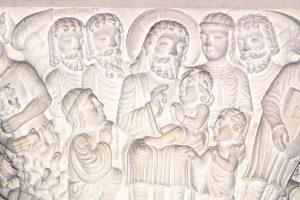Recently I reviewed a newly published Bible study program. It was a creative effort: visually appealing pages, good quality paper, easy to use, with an inventive multimedia approach. In addition, the prayers included in each section were personal and passionate. Even the questions for reflection were, by and large, worth meditating on.
Having written for Bible programs myself, I could see that this group of authors had really done its homework. The publisher was to be commended for putting a serious chunk of money and support behind the effort. Yet, in the end, I declined to give the series my (dubiously valued) imprimatur. The problem wasn’t in the format or the sincerity. It was the message.
The medium is the message, communication theorist Marshall McLuhan once artfully declared. Sometimes that’s the case. But if it were always true, I’d salute every Bible program on the market. I’m so two-thumbs-up about Catholics reading scripture that I’m reluctant to discourage any effort in that direction. But the medium isn’t the whole message. Content really does matter. If a program aims in a direction opposite to where church teaching is going, that approach can certainly bring about as much confusion as illumination.
How can we know what the church authentically teaches about the Bible? The year 1943 is of great significance in the realm of biblical understanding. It was the year Pope Pius XII issued his encyclical Divino Afflante Spiritu (Inspired by the Holy Spirit), a document sometimes rightly dubbed the Magna Carta of biblical teaching for the modern world. Rejecting approaches that are uniformly literal or over-allegorical, this encyclical acknowledges the contributions of generations of diligent scholars who study our sacred texts. These scholars come to a profound appreciation of how these texts functioned in the culture and era of the inspired writers who produced them. Their work helps us to explore ways these texts might have meaning for us in our culture and times. Bible scholars develop a keen awareness of when a story is meant to reflect historical events and when it’s intended as a moral lesson—say, the difference between what Jesus did versus the parables he taught.
A single scholar, or even a handful of researchers, may form a theory about a particular passage that goes no further than a very educated opinion. This might appear as a “what-if” essay appearing in a biblical journal that seeks affirmation or contradiction from peers working on the same material. There’s nothing binding about a theory, although it may be intriguing to explore. However, when the bulk of Bible scholars—over time and through the production of a great body of research—forms a consensus about a text, a theory moves from the realm of scholarly consideration to valid teaching. Nothing in this process is flippant and none of it careless.
I realize I’m doing more technical talk here than this column generally contains. But here’s a story that may help bring it down to earth. I had a New Testament professor who taught a summer class on John’s gospel. At the start of the semester, he playfully proposed that John wrote his gospel first—that is, before the parallel story lines of Mark, Matthew, and Luke took shape.
This idea counters the universal conviction of scholars: that Mark, Matthew, and Luke wrote their accounts within a generation after the resurrection and are therefore more historical in detail. By contrast, John’s gospel—written at least a full generation later—represents a more developed theology about who Jesus is for the emerging church. To present his important theological reflections about Jesus, John “bends” the organization of his narrative, choosing clarity of purpose over the historical timeline in many instances. This is why John’s narrative departs from the other three gospels 90 percent of the time. This doesn’t make John “wrong.” It does mean we need to read John from a different perspective because of what his narrative intends to reveal to us.
Meanwhile, here was my summer professor inviting us to turn this solidly affirmed gospel ordering upside down! If John’s gospel came first, he theorized, what would change in our understanding about the life, ministry, and teaching of Jesus? What difference would it make to the church and its sacraments? Basically, how would such a sudden discovery alter the way we live our faith? We were invited into a semester-long thought experiment about how our beliefs about scripture change the nature of what we read and the message we receive.
Back to Pope Pius XII. When he wrote Divino Afflante Spiritu, he wasn’t inventing a new method of viewing scripture. He was simply promoting what scholars were already doing: studying extra-biblical source materials, being mindful of the crosscurrents of history and culture that produced the sacred stories, and avoiding excessive use of figurative meaning that threatened to turn every square inch of the Bible into a Judeo-Christian version of Aesop’s fables. This encyclical encouraged taking the Bible seriously by taking it in its fullest context in order to reveal its fullest meaning.
When the Second Vatican Council issued its teaching on scripture in 1965—the Dogmatic Constitution on Divine Revelation (Dei Verbum, or “Word of God”)—it embraced the path Pius XII had indicated for preachers and teachers of scripture. Dei Verbum acknowledges that while divine revelation doesn’t change, our appreciation of it does. Contemplation of scripture remains a process, not a done deal. Those of us who prefer our traditions nailed down will struggle with this, but any use of the Bible that insists “this means this, period” puts blinders on the process of revelation.
These teachings have implications for how we Catholics read and teach scripture. Among the things to look for in Bible study material is not simply what it says, but also what it doesn’t say. Scripture can’t remain a practice of personal piety: as in “I read a verse a day, which makes me holier than folks who don’t.” Some programs inadvertently suggest this in remaining laser-focused on praying the texts or finding personal inspiration for today in each passage.
Others pursue Bible texts as historical documents: “This is what those ancient people did, and isn’t it strange and interesting?” The sacred writers didn’t intend to write prayer books (except the psalmists, who wrote a prayer book!). Nor did they envision their contributions as historical documents to be filed away. The sacred writers hoped to tell the people of God who they are—and warn, urgently, who they must not be.
The third unfortunate path some group Bible studies take is to encourage the idea that our task is to share our opinions of these passages: “What do you think about the judges, Margaret?” “Do you agree or disagree with St. Paul here, Josh?” (Trust me: Paul isn’t seeking our advice.)
Any Bible study worth the investment should lead us back from our prayer hour and the Holy Land to our own land and our present generation. Yes, the composers of these texts cared about personal morality and holiness very much. They also cared deeply about God’s concerns: justice and peace, the fate of the poor and the protection of the vulnerable. Scripture urges us to share these concerns, to ask how such people fare in our own society—and what we intend to do about it.
This article also appears in the June 2023 issue of U.S. Catholic (Vol. 88, No. 6, pages 47-49). Click here to subscribe to the magazine.
Image: Unsplash?Carl Beech














Add comment